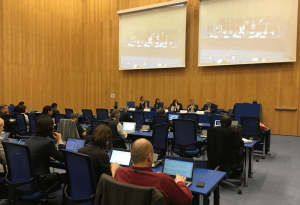By Juan Fernandez Ochoa
Team Assistant – IDPC
Despite perceived novelty, drugs have been online from the Internet’s very beginnings. Anecdotal as it may be, it is widely understood that the very first transaction on ARPANET involved a small amount of cannabis. Ever since, cyberspace has provided fertile ground for all sorts of drug-related exchanges.
The appeal of the Internet for people who use drugs is evident. Faced with criminalisation, misinformation and stigma “offline”, the world-wide web can offer people who use drugs a space to interact in [relative] anonymity and safety. Online forums, such as Erowid, have provided a platform for people to share experiences and advice related to their drug use; fostering a sense of community that remains difficult to replicate “in real life”.
Silk Road, however, was a game changer. Launched in February 2011, the site was the first “archetypical” crypto-drug marketi. This “eBay for drugs” combined sophisticated encryption, communications and trust technologies to offer a broad range of [mostly illicit] products and services to users around the world. Cannabis, LSD, MDMA and other controlled substances were now just a click away… plus shipping & handling.
As it is often the case with drug-related developments in a context of prohibition, the initial response from public authorities ranged from cluelessness, to politically expedient outrage, to repression. Less than three years into the Silk Road experiment, and before the site’s impact on the market could be fully understood, the FBI shut it down. Its convicted mastermind, Ross Ulbricht, now serves a life sentence without parole in a federal prison in New York.
Mirroring the reality of “physical” markets, dismantling the Silk Road, and subsequent similar operations, have achieved anything but the intended effects. The original site might no longer exist, but dozens more have been created in its stead, with overall sales and reach continuing to grow at a gradual but unwavering pace.
Despite the available evidence, the role of public authorities in this evolving ecosystem continues to go unchecked. The UNGASS Outcome Document urges Member States to “strengthen law enforcement, criminal justice and legal responses, as well as international cooperation, to prevent and counter drug-related criminal activities using the Internet” (Art. 5 p). As if expecting different results from doing the same thing over and over again.
In stark contrast with a mainstream law enforcement discourse that perceives these online markets essentially as “a safe haven for criminals”, the burgeoning field of research on crypto-drug markets reveals a more nuanced landscape. An interdisciplinary research project on trust in these markets by the Global Drug Policy Observatory (GDPO)ii, for instance, can shed light on the short-sightedness of fundamentally repressive law enforcement interventions targeting crypto-drug markets.
Borrowing tools from linguistics, ethnography and computer science, the investigators have sifted through thousands of megabytes of messages from the now-defunct Silk Road[s] 1 and 2iii. The careful analysis of “collocates”iv has made it possible to produce a statistically meaningful snapshot of some of the prevailing discourses in these communications.
One strand of the project, led by Professor Nuria Lorenzo-Dus, revealed that trust among users was largely mediated by the exchange of personal experiences and other forms of knowledge, as well as the provision of advice on how to reduce potential harmful effects of drug use. User-based harm reduction strategies have been previously identified in crypto-drug markets and offline communitiesv. However, by focusing on the issue of trust, the authors centre and highlight the social bonds underpinning this “indigenous harm reduction”. Public authorities should consider the opportuneness of law enforcement responses that might entail weakening these community strategiesvi, favouring interventions that support the life and health of people who use drugs insteadvii.
A second project strand, headed by Martin Horton-Eddison, provides further evidence on the unintended, although not unexpected, consequences of “hard” law enforcement interventions. Using the same methodology and sources, the study suggests the takedown of Silk Road by the FBI acted as a starting gun for technological innovation in crypto-drug markets – resulting in even more difficulties for law enforcement to target the dark net. Specifically, this research captures the emergence of collective concerns about the “escrow” system.
Escrow has been an essential trait of crypto-drug markets, mitigating some of the multiple risks associated to online transactions. A number of these risks are related to the non-abidance by one of the parties to the terms of the sale/purchase. In the absence of formal institutions to act as arbiters, crypto-drug markets stepped in to fill the gap, offering a service that holds the funds until the other parties (in this case the buyer and seller) both agree to release them. When Silk Road 1 was seized, the FBI expropriated $3.6million from the system. Immediately after Silk Road 2 came to exist, users began to discuss ways to offset these potential losses. Intensified by major “exit scams”, these anxieties in the community seem to have led to the development of better alternatives, such as decentralised and multi-signature escrow systems. Law enforcement action, in short, made crypto-drug markets more resilient and possibly sustainable.
The insights from these studies strongly mirror certain realities of offline drug markets. The global drug control regime has a conspicuous track record of futile interventions that are not motivated, and in fact come at the expense of the wellbeing of people who use drugs. Crypto-drug markets, which are often framed as a threat in international policy debates, might actually offer an opportunity to provide remedial action. Public authorities should rethink their engagement with these spaces, capitalising on the self-regulatory and harm reduction practices deployed by these communities to positively influence, support and empower people who use drugs on- and offline.
This blog post draws on material presented at the Roundtable on Cyber-Trust in Crypto-Drug Markets: Implications for Policy and Policing (London, 21 February 2017), organised by the International Institute for Strategic Studies (IISS) and the Global Drug Policy Observatory (GDPO), with support from the International Drug Policy Consortium (IDPC) and the Challenging Human Environments and Research Impact for a Sustainable and Healthy Digital Economy (CHERISH-DE) fund.
Notes
i Crypto-drug markets can be defined as “digital platforms that facilitate P2P trade of goods and services with the added features of recommendations systems and a reliance on cryptocurrencies such as bitcoin. They utilize anonymizing Internet-routing technologies [….] to conceal the physical-[world] identity and location of users and create and open network for such interactions”.
ii Swansea University.
iii February 2011 – October 2013 and Nov. 2013 – November 2014, respectively.
iv Words that co-occur with statistical significance, denoting “features of the data that are both salient and peculiar”. Di Cristofaro, M. & Horton-Eddison, M. (2017) Corpus Linguistics on the Silk Road(s): The Escrow Example, GDPO Situation Analysis.
v See, for instance: Bancroft, A., & Reid, P. S. (2016). Concepts of illicit drug quality among darknet market users: Purity, embodied experience, craft and chemical knowledge. International Journal of Drug Policy, 35, 42–49; and Friedman, S. R., de Jong, W., Rossi, D., Touzé, G., Rockwell, R., Des Jarlais, D. C., & Elovich, R. (2007). Harm reduction theory: Users’ culture, micro-social indigenous harm reduction, and the self-organization and outside organizing of users’ groups. International Journal of Drug Policy, 18(2), 107–117.
vi For more on law enforcement and harm reduction, see, for instance: Monaghan, G., Bewley-Taylor, D., 2013. Modernising Drug Law Enforcement – Report 1 Police Support for Harm Reduction Policies and Practices Towards People Who Inject Drugs. International Drug Policy Consortium, London
vii See, for instance: Caudevilla, F. The Emergence of Deep Web Marketplaces: A Health Perspective. The Internet and Drugs Market (European Monitoring Center for Drugs and Drug Addiction). Publications Office of the European Union, Luxembourg; 2016.

